一 : God is a girl
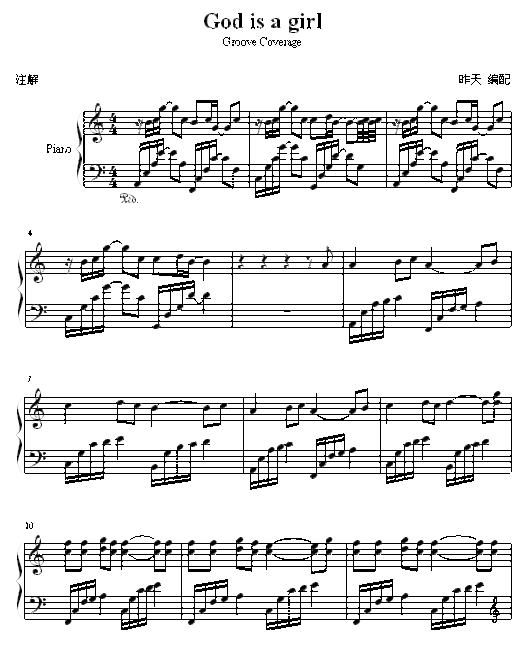
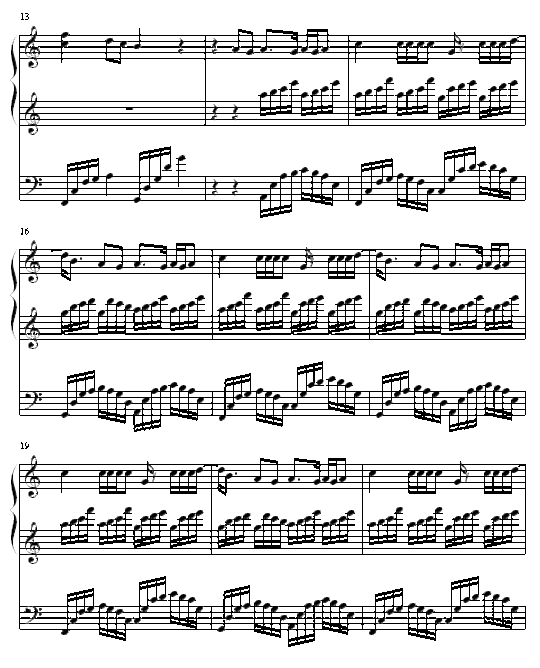
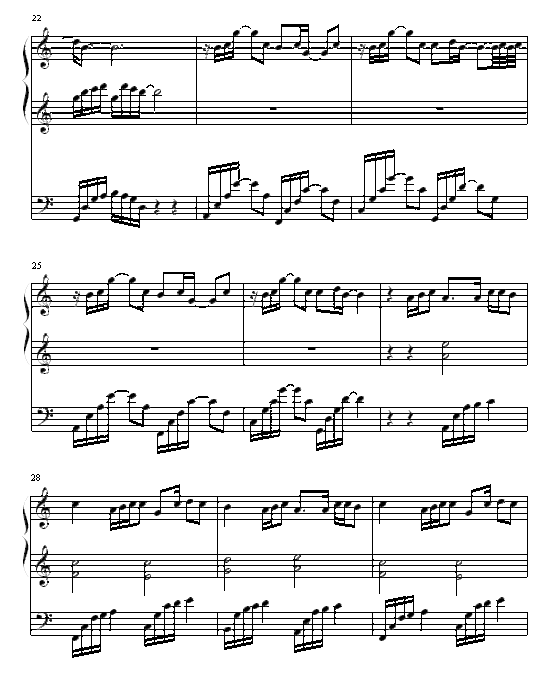


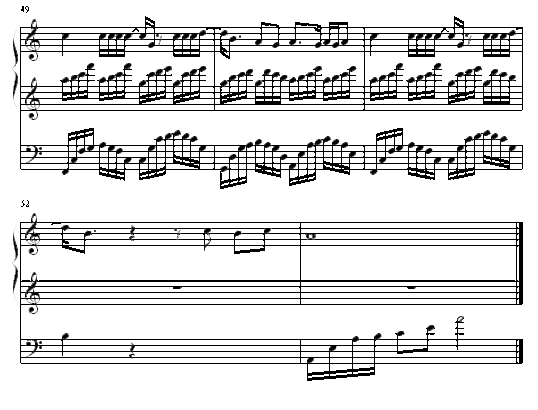
二 : God is a girl(上帝是女孩)吉他谱
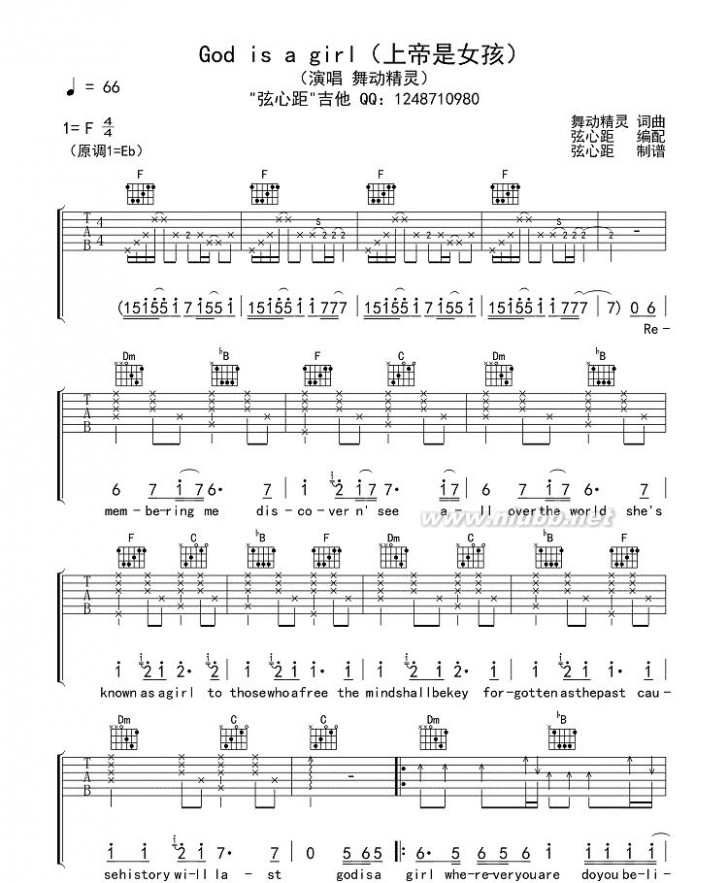
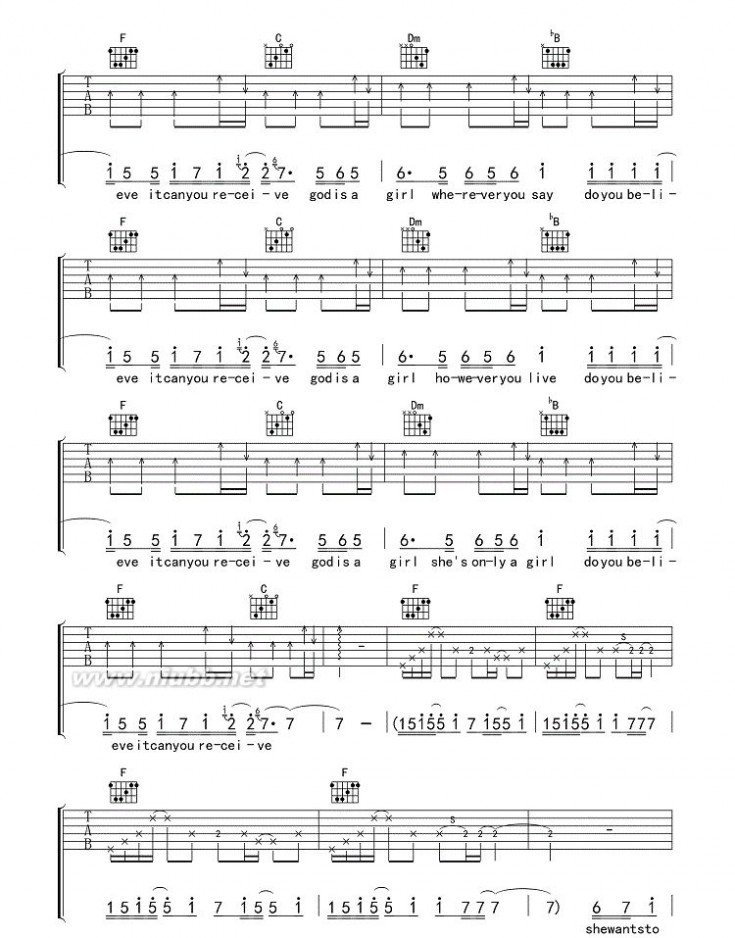

三 : 句型转换。1. My sister is a very lovely girl. (感叹句)
| 句型转换。 |
| 1. My sister is a very lovely girl. (感叹句) _______ _______ _______ girl my sister is! 2. What else did you buy yesterday? (同义句转换) What _______ _______ did you buy yesterday? 3. He is the tallest student in the class. (同义句转换) He is _______ _______ _______ _______ student in the class. 4. I think he is a good student. (改否定句) I _______ _______ he _______ a good student. 5. I go to Beijing twice a year. (对画线提问) ______ ______ ______ you go to Beijing? |
| 1. What a lovely 2. other things 3. taller than any other 4. don't think, is 5. How often do |
考点:
考点名称:感叹句感叹句:一般陈述句转换成How或者What引导的感叹句的方法:
方法:
找出陈述句中的主语和谓语部分,再找出形容词,最后找陈述句中是否包含该形容词修饰的名词部分。
例如:My classmates are very kind and helpful.
分析:
句子的主语是my classmates,谓语(即动词)是are,形容词有kind和helpful,但没有该形容词要修饰的名词。
因此可以转换成How引导的感叹句,根据“How + adj. + 主语 + 谓语!”,
该陈述句可以改成:
How kind and helpful my classmates are!
例如:China is a peaceful country.
分析:
句子中的主语是China,谓语是is,形容词是peaceful,而且有该形容词修饰的名词country,并且,country是可数名词,需要用冠词,原句有冠词a,
因此可以转换成What引导的感叹句,根据“What + n. + 主语 + 谓语!”,
该句子可以改成:
What a peaceful country China is!
感叹句用法:
感叹句多以how或what引导,但在口语中,还有一些特殊的感叹句表达形式。
1.以副词here, there, in开头的感叹句。
Here comes the bus! 公共汽车来了!
There they are! 他们在那儿呢!
2.以疑问词who开头,表示惊奇。
Who else will read such a book! 谁还会读这样的书!
3.以情态动词may开头,表示愿望。
May you both be happy! 祝二位幸福。
May you succeed! 祝你成功!
4.否定疑问句用作感叹句时,它的意义是肯定的;但肯定疑问句用作感叹句在美国英语中比较常见。
Aren’t they sweet! 他们多可爱啊!
I am hungry! 我饿极了!
5.一些短语用作感叹句。
Dear me! 哎呀! My goodness! 嗳呀!
None of your nonsense! 不要胡说了!
6.一些作表语的成分用作感叹句。
Just my luck! 又倒霉了!
Sorry, my mistake! 对不起,是我的错!
7.以从句表示的感叹句。例如:
As if were my fault!好像是我的错似的!
To think a scandal of this sort should be going on under my roof!真想不到这种丑事竟然出在我们家里!
形容词的比较级和最高级的特殊变化规则:
一、少数单音节词前面加 more-, most- 构成比较级和最高级
tired ---- more tired , most tired
fond ----- more fond , most fond
glad ----- more glad , most glad
bored ---- more bored , most bored
pleased---- more pleased , most pleased
二、不规则变化
good /well------- better ,best
bad/badly/ill------ worse , worst
many/much-------more , most
little ------ less , least
far ---- farther, farthes / firther , furthest
old ---- older , oldest (GA)
---- older , oldest / elder , eldest (GB)
三、下列形容词和副词的比较级和最高级有两种形式
cruel----- crueler, cruelest /more cruel , most cruel
strict---- stricter , strictest /more strict , most strict
often----- oftener , oftenest /more often , most often
friendly------ friendlier , friendliest /more friendly , most friendly
clever----- cleverer, cleverest / more clever , most clever
四、下列形容词和副词没有比较级和最高(即表示”最高程度”或”绝对状态”的形容词和副词没有比较级和最高级)
empty , wrong , perfect , unique , extreme , excellent , favourite (GB)/ favorite (GA) , true , right , correct , extremely ...
构成 | 原级 | 比较级 | 最高级 |
一般加er,est | tall | taller | tallest |
以字母e结尾只 | large | larger | largest |
以一个辅音字母结尾的 | red | redder | reddest |
hot | hotter | hottest | |
thin | thinner | thinnest | |
| easy | easier | easiest |
happy | happier | happiest | |
ugly | uglier | ugliest | |
early | earlier | earliest | |
其他双音节词和多 | interesting | more interesting | most interesting |
形容词的几个特殊用法:
most 同形容词连用而不用 the, 表示 " 极,很,非常, 十分"。
It's most dangerous to be here. 在这儿太危险。
I cannot do it, it's most difficult. 我干不了这件事,太难了。
"The+形容词比较级..., the+形容词比较级..." 表示 " 越... 就越..."。
The more you study, the more you know. 你学的越多, 就知道的越多。
The more I have, the more I want. 我越有就越想要有。
The more, the better. 越多越好。
" 形容词比较级 + and + 形容词比较级 ", 表示 " 越来越... "。
It's getting hotter and hotter. 天气越来越热了.
It's pity he is getting poorer and poorer. 真可怜他越来越穷了。
The computer is cheaper and cheaper. 计算机越来越便宜。
The more and more people focus on the meeting next year. 越来越多的人关注明年的会议。
主语+谓语(系动词)+as+形容词原形+as+从句。表示两者对比相同。
This box is as big as mine. 这个盒子和我的一样大。
This coat is as cheap as that one. 这件衣服同那件衣服一样便宜。
I study English as hard as my brother. 我同我兄弟一样学习努力。
the + 形容词 表示某种人。
He always helps the poor. 他经常帮助穷人。
I like to have a talk with the young. 我喜欢同年轻人谈话。
The rich sometimes complain their empty life. 富人有时抱怨他们空虚的生活。
The police led the old man across the street. 警察领老人横过马路。
以-ly结尾的形容词
1) 大部分形容词加-ly可构成副词。但 friendly,deadly,lovely,lonely,likely,lively,brotherly,仍为形容词。
改错:(错) She sang lovely. (错) He spoke to me very friendly.
(对) Her singing was lovely. (对) He spoke to me in a very friendly way.
2)有些以-ly 结尾的词既为形容词,也为副词。
daily,weekly,monthly,yearly,early
The Times is a daily paper.
The Times is published daily.
too+adj.+to句型 “太…而不能”
He is too young to go to school.
=He isn’t old enough to go to school.
=He is so young that he can’t go to school.
形容词的位置:
1.形容词一般放在名词前作定语?
单个形容词修饰名词时,一般要放在名词的前面。它们的前面常常带有冠词、形容词性物主代词、指示代词、数词等。例如:?
a red flower一朵红花?
an interesting story一个有趣的故事?
six blind men 六个盲人?
my own house我自己的房子?
如果有两个或两个以上的形容词修饰一个名词时,则由它们和被修饰的名词之间的密切程度而定,越密切的形容词越靠近名词。
如果几个形容词的密切程度差不多则按音节少的形容词放在前面,音节多的形容词放在后面。
2.当形容词所修饰的词是由some,any,every,no等构成的不定代词时,形容词必须置于名词之后。例如:?
She has something new to tell me.?她有一些新的情况告诉我。?
I have nothing important to do today.?今天我没有重要的工作要做。?
Do you know anybody else here??这儿你还有认识的人吗??
3.形容词后面有介词短语或不定式短语时,形容词必须置于名词之后。例如:?
It is a problem difficult to work out.?这是一道难以解决的问题。?
Edison is a student difficult to teach.?爱迪生是个很难教的学生。?
This is a kind of flowers easy to grow.?这是一种易栽的花。?
4.用 and 或 or 连接起来的两个形容词作定语时一般把它们放在被修饰的名词后面。起进一步解释的作用。例如:?
All people,young or old,should be strict with themselves.?
所有的人,无论老少,都应该严格要求自己。?
We are building a new school, modern and super.?
我们正在建一所现代化的高档次的新型学校。?
All countries, rich and poor, should help one another. 所有的国家,无论穷富都应该互相帮助。?
5.有少数形容词,如enough和possible,既可置于所修饰的名词前面也可以置于它所修饰的名词之后。例如:?
Do you have enough time(time enough)to prepare?你有足够的时间做准备吗??
Maybe it will be a possible chance(chance possible)for you.或许它将成为一次可能的机遇。
6.有些形容词,置于名词之前与之后,含义不尽相同。例如:?
the writer present 出席的作者?
the present writer 现在的作者?
7.表示长,宽,高,深,及年龄的形容词,应放在相应的名词之后。
This river is about 100 metres wide.
The building is more than 50 metres tall.
He is less than 40 years old.
8. enough修饰名词时,在名词前后都可以。
They said that they had enough food.=They said that they had food enough.
enough 修饰形容词和副词,位于其后。
He is old enough to join the army.
He isn’t old enough to go to school.
9.形容词else通常放在疑问代词,疑问副词或不定代词后
what/who/where/when/when else
something/anything/nothing…else
What else did you do?
Do you have anything else to say?
10.由两个或两个以上的词组成的形容词词组修饰名词时须放在名词之后。
This is the book easy to read.
这是一本容易读的书。
宾语从句的特点:
1.宾语从句可以作及物动词、介词及形容词的宾语。
2.宾语从句的语序一律用陈述句语序。
3.连接词that引导宾语从句在句中无词义,不充当句子成份,多数情况下可以省略。
4.whether 和 if 都可引导宾语从句,但 whether后可紧跟or not;whether从句可作介词的宾语。
5.如果从句太长,可以用形式宾语it.
宾语从句的时态:
1.主句是一般现在时,从句根据实际情况使用任何时态。
例句:The headmaster hopes everything goes well.
2.主句是过去时态,从句须用过去时态的某种形式。
例句:She was sorry that she hadn’t finished her work on time.
3.当宾语从句表示的是一个客观真理或者事实时,即使主句是过去时,从句也用一般现在时态。
例句:The teacher told his class that light travels faster than sound.
4.如果从句的动作发生在主句之前,则从句要用过去完成时态。
宾语从句的语序:
A. 宾语从句必须用陈述语序。
False: He is wondering when can he finish this difficult job.
Right: He is wondering when he can finish this difficult job.
B. 有时候可以用it 作形式宾语,而把真正的宾语从句放在后面。
Bad: I thought that he could finish this job in just two hours impossible.
Good: I thought it impossible that he could finish this job in just twohours.
C. 带有宾语从句的复合句的否定形式一般是否定主句。
Bad: I think he doesn’t like the English teacher.
Good: I don’t think he likes the English teacher.
D.主句一般过去时态,从句也要用过去时态。
False: He wanted to know why he is crying in the corner.
Right: He wanted to know why he was crying in the corner
宾语从句的否定转移:
主句的谓语动词是think,believe,imagine,suppose,consider,espect,fancy,guess等。
并且主句的主语是第一人称而且为一般现在时,从句的否定词一般要转移到主句上来,其反义疑问句一般与宾语从句一致。
I don’t think he will come to my party.而不能说成I think he won’t come to my party.
我认为他不会来我的舞会.
I don’t believe that man is killed by Jim,is he?
我认为那个人不是Jim所杀的,是不是?
如果宾语从句中有某个含有否定意义的形容词或副词,其反义疑问句要用肯定形式。
We find that he never listens to the teacher carefully,does he?
我们发现他从来不仔细听老师讲课,是不是?
宾语从句中引导词的用法比较
在复合句中作主句的宾语,引导词有:
连词:that (that 常可省略),whether, if
代词:who, whose, what ,which
副词:when ,where, how, why 等。
(一)that引导的宾语从句(在非正式场合that可以省略)
1.可跟that从句做宾语的动词有:
say, think, insist, wish, hope, demand, imagine, wonder, know, suppose, see, believe, agree, admit, deny, expect, explain, order, command, feel, dream, suggest, hear, mean, notice, prefer, request, require, propose, declare, report等。
例句:The boy believes that he will travel through space to other planets.
注意事项:当主句谓语动词是 think, believe, suppose, expect 等词,而宾语从句的意思是否定时,常把否定转移至主句表示。
例句:I don’t think it is right for him to treat you like that.
2.在以下情况中that不能省略
a.当句中的动词后接多于两个由that引导的宾语从句时,第一个that可省,但后面的that不可省。
例句:He said (that) you were too young to understand the matter and that he was asked not to tell you.
b.当主句的谓语动词与that宾语从句之间有插入语时,that一般不可省。
例句:Just then I noticed, for the first time, that our master was wearing his fine green coat and his black silk cap.
c.当that从句是双宾语中的直接宾语时,that不可省。
例句:I can’t tell him that his mother died.
d.注:许多带复合宾语的句子,that引导的宾语从句经常移到句子后部,而用it作形式宾语。
例句:I find it necessary that we should do the homework on time.
(二)由whether,if 引导的宾语从句
1.由whether(if)引导的宾语从句,实际上是一般疑问句演变而来的。意思是“是否”。宾语从句要用陈述句语序。
一般说来,在宾语从句中whether与if可以互换使用,但在特殊情况下if与whether是不能互换的。
例句:I wonder whether(if) they will come to our party.
2.只能用whether,不能用if引导的宾语从句
a.在带to的不定式前
例句:We decided whether to walk there.
b.在介词的后面
例句:I’m thinking of whether we should go to see the film.
c.在动词后面的宾语从句时
例句:We discussed whether we had a sports meeting next week
d.直接与or not连用时
例句:I can’t say whether or not thet can come on time.
3.只能用if不能用whether引导的宾语从句
a.if引导条件状语从句,意为“如果”
例句:The students will go on a picnic if it is sunny.
b.if引导否定概念的宾语从句时
例句:He asked if I didn’t come to school yesterday.
c.引导状语从句even if(即使)和as if(好象)时
例句:He talks as if he has known all about it.
if,whether在宾语从句中的区别
a.if和whether在作“是否”解时,引导宾语从句常放在动词know,ask,care,wonder,find out等之后,介词后一般不用if
b.少数动词,如:leave,put,discuss,doubt后的宾语从句常用whether.
c. whether后可以加or not,但是if不可以.
d.在不定式前只能用whether.
(如:I can’t decide whether to stay. 我不能决定是否留下。)
e.避免歧异时,我们常用whether而不用if.
(三)连接代词和连接副词引导的宾语从句
这样的宾语从句实际上是由特殊疑问句变化而来的,宾语从句要用陈述句语序。
用于这种结构的动词常常是:see, say, tell, ask, answer, know, decide, show, find out, imagine, suggest, doubt, wonder, discover, understand, inform, advise等。
1.英语中的连接代词有:who,whom,whose,which,what,在句中担任主语、宾语、定语或者表语。
例句:Can you tell me whom you are waiting for?
2.英语中的连接副词有:when,where,why,how,在句中担任状语的成分。
例句:None of us knows where these new parts can be bought.
简化宾语从句常用六法:
方法一:
当主句谓语动词是hope, decide, wish, choose, agree, promise等,
且宾语从句的主语与主句主语一致时,宾语从句可简化为不定式结构。
例如:
Li Ming hopes he will be back very soon.
→Li Ming hopes to be back very soon.
We decided that we would help him.
→We decided to help him.
方法二:当主句谓语动词是know, learn, remember, forget, tell等动词,
且主句主语与从句主语一致时,宾语从句可简化为“疑问词+不定式”结构。例如:
She has forgotten how she can open the window.
→She has forgotten how to open the window.
注:当主句谓语动词是tell, ask, show, teach等动词,
且后带双宾语,从句主语和间接宾语一致时,宾语从句可简化为“疑问词+不定式”结构。例如:
Could you tell me how I can get to the station?
→Could you tell me how to get to the station?
方法三:当主句的谓语动词是order(命令),require(需要)等时,
如果主句和从句的主语不一致,宾语从句可简化为“名词(代词)+不定式”结构。例如:
The headmaster ordered that we should start at once.
→ The headmaster ordered us to start at once.
方法四:某些动词后的宾语从句,可以用介词加动名词(短语)等其他形式简化。例如:
He insisted that he should go with us.
→He insisted on going with us.
The poor boy doesn’t know when and where he was born.
→The poor boy doesn’t know the time and the place of his birth.
方法五:某些动词后面的宾语从句可转化为“宾语+V-ing形式(作宾语补足语)”结构。例如:
Liu Ping found that there was a wallet lying on the ground.
→ Liu Ping found a wallet lying on the ground.
方法六:动词seem后的宾语从句,也可以用不定式(短语)来简化,但句型需要进行适当的变化。例如:
It seemed that the boys were going to win.
→The boys seemed to win.
除上述方法外,还有一些特殊句式的转化。例如:
I found that it was difficult to learn English well.
→I found it difficult to learn English well.
Soon we found that the ground was covered with thick snow.
→Soon we found the ground covered with thick snow.
They found that the box was very heavy.
→They found the box very heavy
与how搭配的疑问词组:
How在英语中通常用作副词,是特殊疑问句中本领最大的疑问词。他与其它形容词或副词搭配组成疑问词组
1.How old问年龄、年代。
How old is your friend? 你朋友多大了?
How old is the bridge? 这座桥有多少年代了?
2.How many问可数名词数量。常将可数名词复数紧随其后。如:
How many pictures are there on the wall? 墙上有多少幅画?
How many glasses of milk would you like? 你们想要几杯牛奶?
3.How much询问不可数名词的数量、物品的价格。
How much money is there in the purse? 钱包里有多少钱?
How much are the apples at the moment? 目前苹果什么价钱?
4.How long提问物体的长度、时间的长短。
How long is the Changjia River? 长江有多长?
How long does it take you to do your homework every day?
你每天花多长时间做作业?
5.How soon 对 “in+一段时间 ”提问, 表示“多久之后”。
How soon will you be back? 你多久后回来?
6.How often对表示频率的副词或短语提问。
How often does Mrs. Green go shopping? 格林夫人多久去购一次物?
7.How about用来征求对方意见。
Your father is a worker, how about your mother? 你父亲是工人,你母亲呢?
How about playing games after school this afternoon? 下午放学后做游戏怎么样?
8.How far 问两地间的距离How tall问人(树)的高度;how heavy问重量;how wide问宽;how high可以询问建筑物、山峰高度。
How far is it from the earth to the moon? 从地球到月球有多远?
How tall is Yao Ming? 姚明身高多少?
How heavy is that big box? 那只大箱子有多重?
How wide is the new street? 这条新街有多宽?
How high is the tower in Paris? 巴黎的那座塔有多高?
与what搭配的疑问词组:
| 疑问词 | 意思 | 用法 | 例句 |
| what | 什么 | 用来问是什么,叫什么,做什么等 | 1. What’s your name? 你叫什么名字? 2.What’s your father? 你爸爸是干什么的? 3.what is in your box? 你的盒子里是什么? |
| what time | 什么时间 | 用来问时间 | 1.What time is it? 几点了? 2.What time is it now? 现在几点了? |
| what colour | 什么颜色 | 用来问颜色 | 1.waht colour is your bag? 你的书包是什么颜色? 2.what colour is your book? 你的书本是什么颜色? |
| what about | 怎么样 | 用来征求意见或询问感受等, 大多用于承接上面的同样问题 | 1.what bout this pair of shoes?这双鞋子怎么样? |
| what day | 星期几 | 用来问星期几 | 1.what day is it today? 今天星期几? 2. what day was yesterday? 昨天星期几? |
| what date | 什么日期 | 问具体的日期 | 1.What’s the date today? 今天是几号? 2. what date is tomorrow? 明天是几号? |
| what...for... | 为何目的 | 用来问目的,在一定情况下只可以与why互换 | What did you buy that for? 你为什么要买那个? |
四 : God is a girl吉他谱/六线谱(上帝是女孩)
God is a girl吉他谱/六线谱(上帝是女孩) 作词:舞动精灵 作曲:舞动精灵 演唱(奏):舞动精灵 格式:六线吉他谱

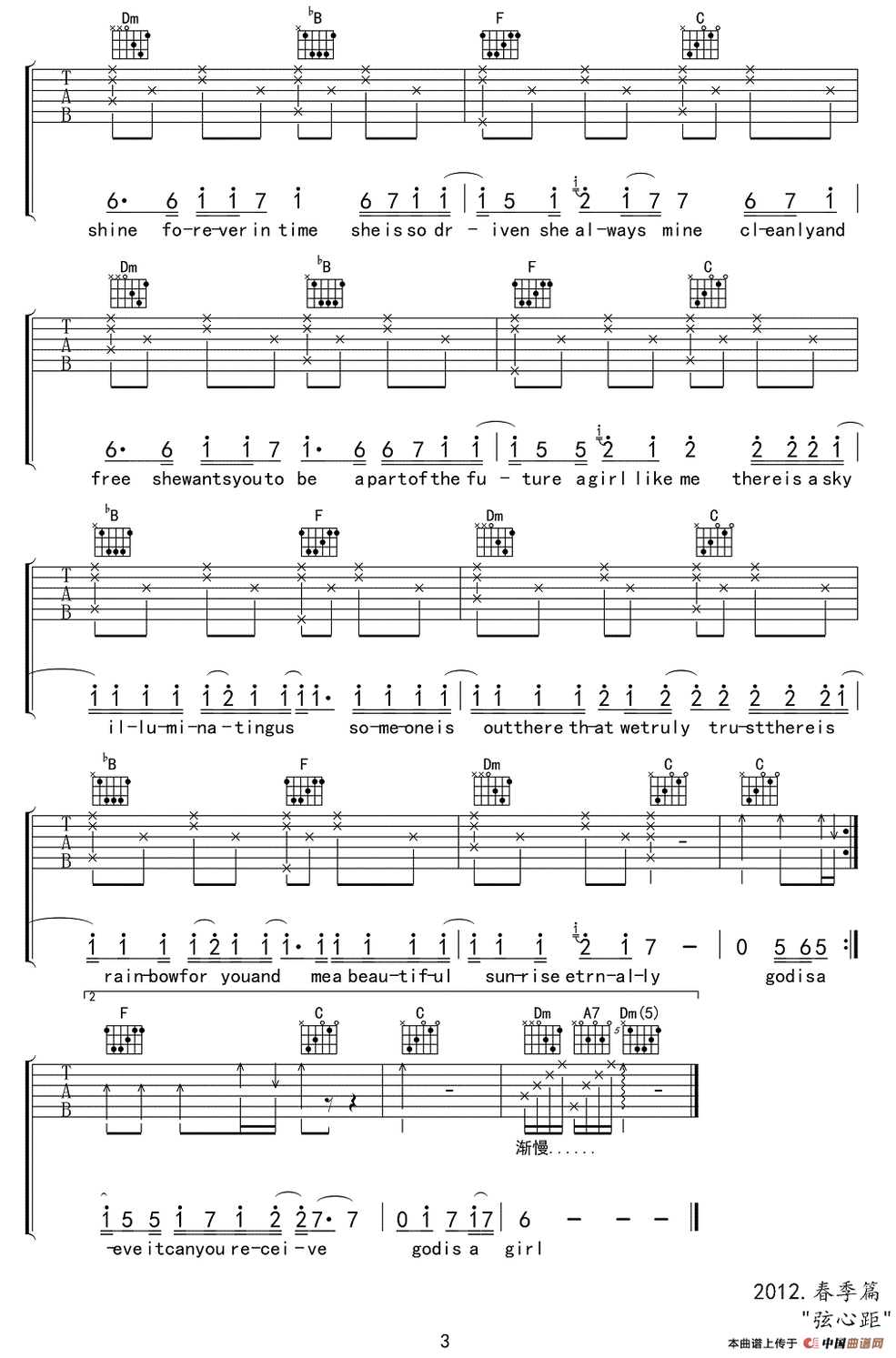
转自《17吉它谱网》
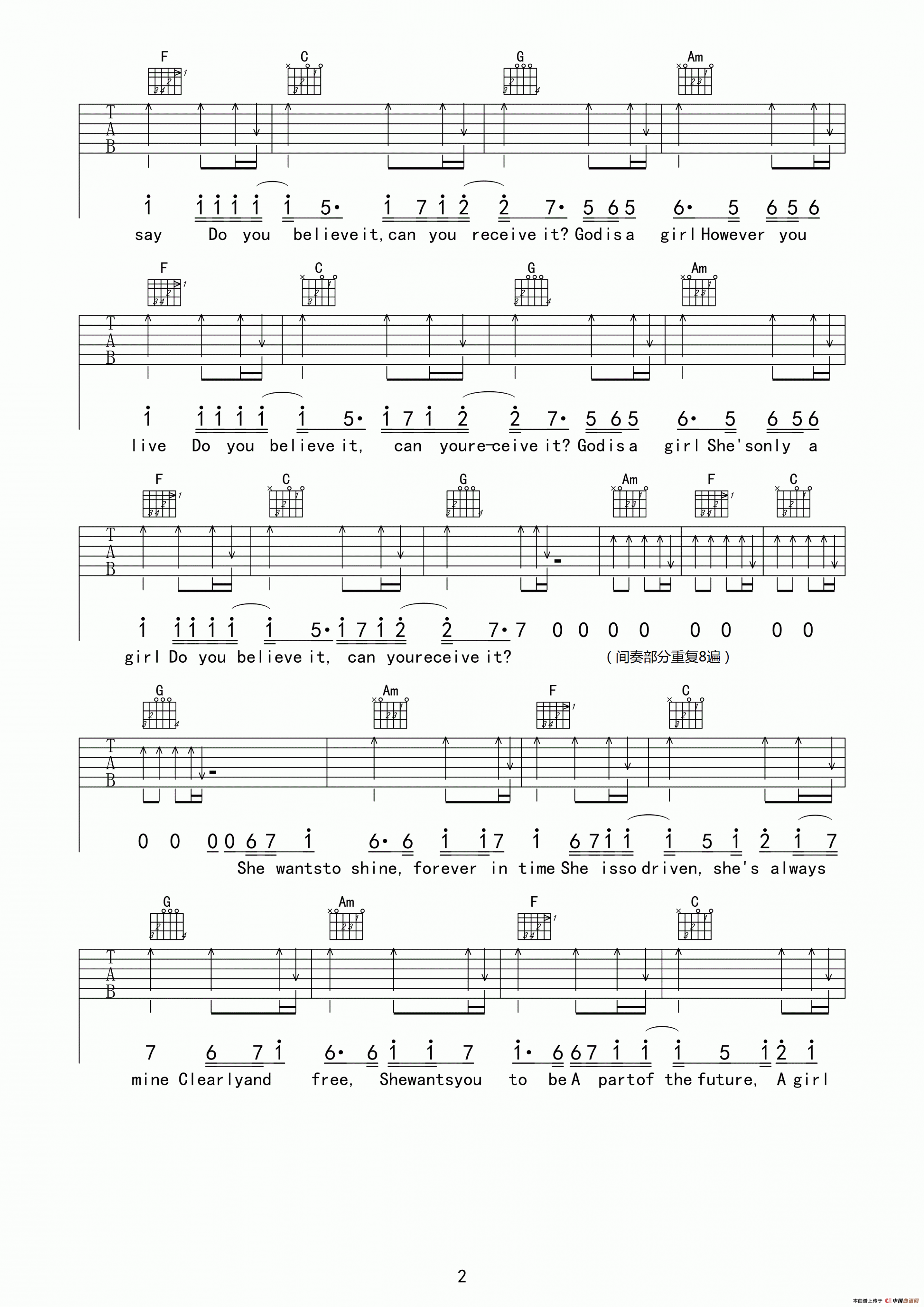 本文标题:god is a girl-God is a girl
本文标题:god is a girl-God is a girl 61阅读| 精彩专题| 最新文章| 热门文章| 苏ICP备13036349号-1